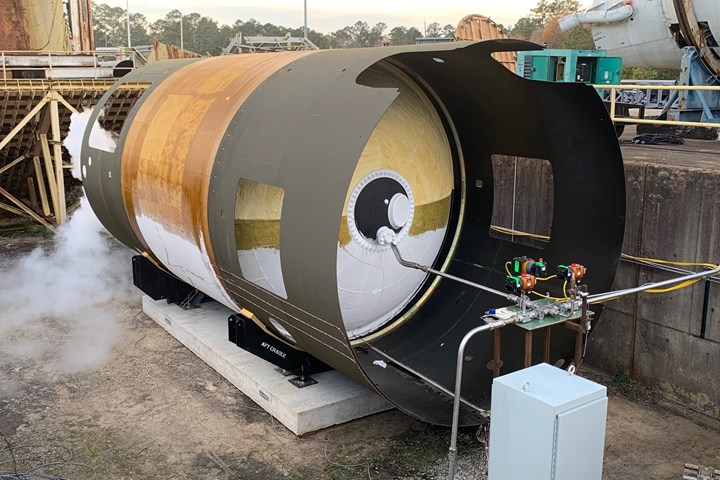On the radar: Cryogenic testing of composites for future hydrogen storage
Netherlands, U.K., France, Germany and the U.S. build up test capability, look at thermoset and thermoplastic composite materials.
Boeing’s all-composite cryogenic fuel tank undergoing pressure testing at NASA’s Marshall Space Flight Center. Photo Credit: Boeing
For the past few years, composite cryogenic storage tank innovations reported on by CW have consistently targeted the space and aerospace markets. As hydrogen continues to dominate via the global transition to clean, zero-emissions transportation, the development of thermoset and thermoplastic tank options have come to the forefront — even in automotive.
In December 2021, Toray Advanced Composites (TAC, Nijverdal, Netherlands) announced the Netherlands (NL) LH2 composite tank consortium to develop a long-life, fully thermoplastic composite LH2 tank for civil aviation.
“We have set up additional facilities for testing composite materials at 20 Kelvin,” says Henri de Vries, senior scientist composites at Netherlands Aerospace Center (NLR, Marknesse), one of the project consortium members. “And we are already busy with testing materials to measure if they can resist microcracking and permeation of H2 through the laminate. We have experience from our work on the engine thrust frame for the Ariane 6 launch vehicle, but that was at a higher temperature, closer to 80 Kelvin. And even though we are testing thermosets, this is mostly to establish a benchmark. We focus instead on thermoplastics, which is also the expertise of TAC, because we have seen interesting properties at very low temperatures for semicrystalline polymers such as polyaryletherketones [e.g., PAEK, PEEK, PEKK].”
According to de Vries, the testing will take 18 months. “The first test results already look promising,” he notes. “And we are doing a lot of permeability testing in order to select the best materials.”
In Type IV compressed gas hydrogen (CGH2) tanks, the carbon fiber-reinforced epoxy is wound around an unreinforced nylon or high-density polyethylene (HDPE) liner as a permeability barrier. How will this be achieved in the demonstrator composite LH2 tank? “The composite material itself is not that bad,” says de Vries. “We have one already that has survived thermal cycling in liquid helium at -269°C. Further testing is necessary, but it’s hard to do a 20-year life’s worth of testing within a few months.”
A similar capability is being established within the U.K.’s ASCEND program, which is “striving to provide potential solutions for aircraft OEMs to produce higher rate, more composites-intensive aircraft components.” Specifically in Theme 4: Electrification and multifunctional, it is noted that “these work packages will introduce integrated, multifunctional airframe structures — including nanomaterial-based de-icing systems developed by partner Hive Composites, integrated electrical wiring in composite panels and material concepts for a Type V cryogenic hydrogen tank for use on future zero-emissions, net-zero aircraft. Within the tank work package, goals include exploring the global supply chain for cryogenic-suitable composite materials, while also, in the U.K., developing the test capability to validate cryogenic performance at a coupon level and understanding manufacturing capabilities for filament-wound or braided tanks.”
Moreover, in February 2022, a new type of large, fully composite, linerless cryogenic fuel tank, designed and manufactured by Boeing (Chicago, Ill., U.S.) and managed by NASA, passed a critical series of tests. The test, which “builds upon Boeing’s extensive experience with the safe use of hydrogen in aerospace applications will inform Boeing’s ongoing studies of hydrogen as a potential future energy pathway for commercial aviation. In addition to use in space programs, Boeing has completed five flight demonstration programs with hydrogen.”
In automotive, part of Forvia’s (Nanterre, France) developments and strategy for enabling the clean mobility transition include cryogenic hydrogen storage tanks using thermoset and thermoplastic composites. The company has introduced the Cryogenic Hydrogen Storage solution developed by subsidiary Faurecia, leveraging the higher energy density of liquid hydrogen (LH2). It is offered in a more compact version that “enables the same quantity of H2 to be stored within a 40% reduced volume (versus 700-bar CGH2 tanks).”
Forvia, in collaboration with Air Liquide (Paris, France) also targets heavy-duty vehicle transportation with the manufacture of a subcooled liquid hydrogen (sLH2) cryogenic tank (maximum pressure of about 20 bar).
Cryo-compressed hydrogen (CcH2) was developed for automotive by BMW (Munich, Germany, reports published from 2006-2013), now carried forward by Cryomotive (Taufkirchen, Germany) using an insulated carbon fiber-reinforced polymer (CFRP) tank system. Once commercialized, Cryomotive’s full-scale demonstrator tanks for trucks will range from 600 to 700 millimeters in diameter and 2,350 to 2,650 millimeters in length to hold 75 to 115 kilograms of CcH2 gas in two- to four-tank system configurations.
“We found that if you compress LH2 into a cryogenic gas at 30 or 40 megapascals [300 or 400 bar], you can basically increase its density,” explains Dr. Tobias Brunner, co-founder of Cryomotive. “That was the first hypothesis that no one believed, but we built a pump with Linde and showed we could produce a high-pressure CRYOGAS at 30 megapascals with a density of 80 grams/liter compared to between 65 and 70 grams/liter for LH2.”
Related Content
Collins Aerospace to lead COCOLIH2T project
Project for thermoplastic composite liquid hydrogen tanks aims for two demonstrators and TRL 4 by 2025.
Read MoreRecycling hydrogen tanks to produce automotive structural components
Voith Composites and partners develop recycling solutions for hydrogen storage tanks and manufacturing methods to produce automotive parts from the recycled materials.
Read MoreUpdate: THOR project for industrialized, recyclable thermoplastic composite tanks for hydrogen storage
A look into the tape/liner materials, LATW/recycling processes, design software and new equipment toward commercialization of Type 4.5 tanks.
Read MoreComposites end markets: Batteries and fuel cells (2024)
As the number of battery and fuel cell electric vehicles (EVs) grows, so do the opportunities for composites in battery enclosures and components for fuel cells.
Read MoreRead Next
All-recycled, needle-punched nonwoven CFRP slashes carbon footprint of Formula 2 seat
Dallara and Tenowo collaborate to produce a race-ready Formula 2 seat using recycled carbon fiber, reducing CO2 emissions by 97.5% compared to virgin materials.
Read More“Structured air” TPS safeguards composite structures
Powered by an 85% air/15% pure polyimide aerogel, Blueshift’s novel material system protects structures during transient thermal events from -200°C to beyond 2400°C for rockets, battery boxes and more.
Read MoreDeveloping bonded composite repair for ships, offshore units
Bureau Veritas and industry partners issue guidelines and pave the way for certification via StrengthBond Offshore project.
Read More



























